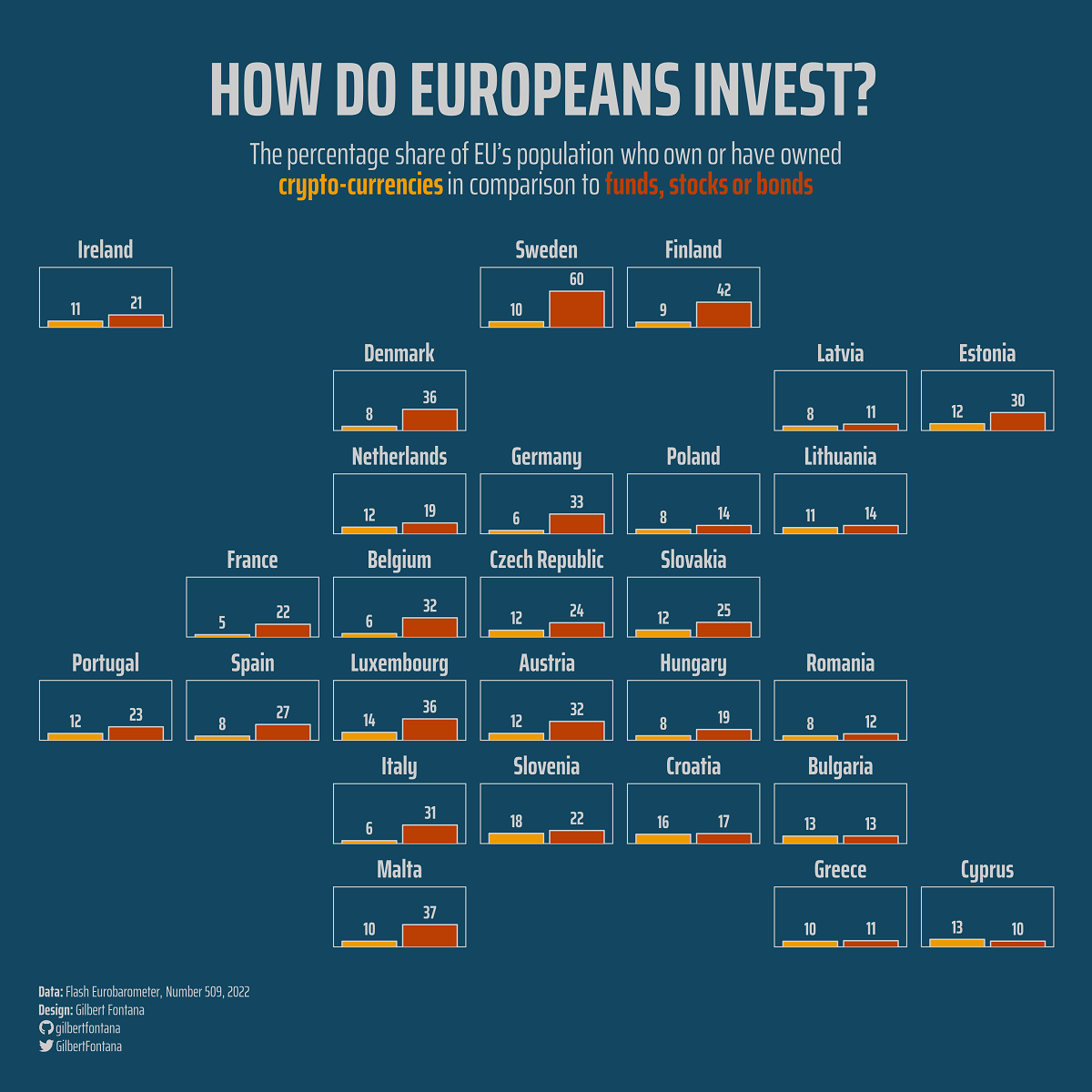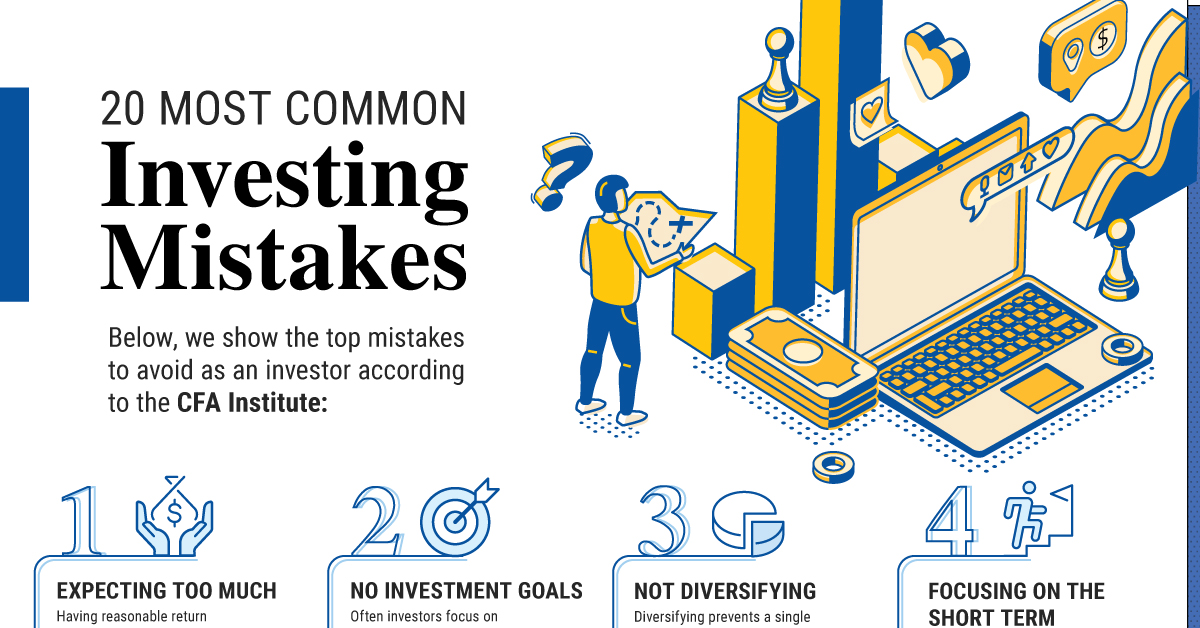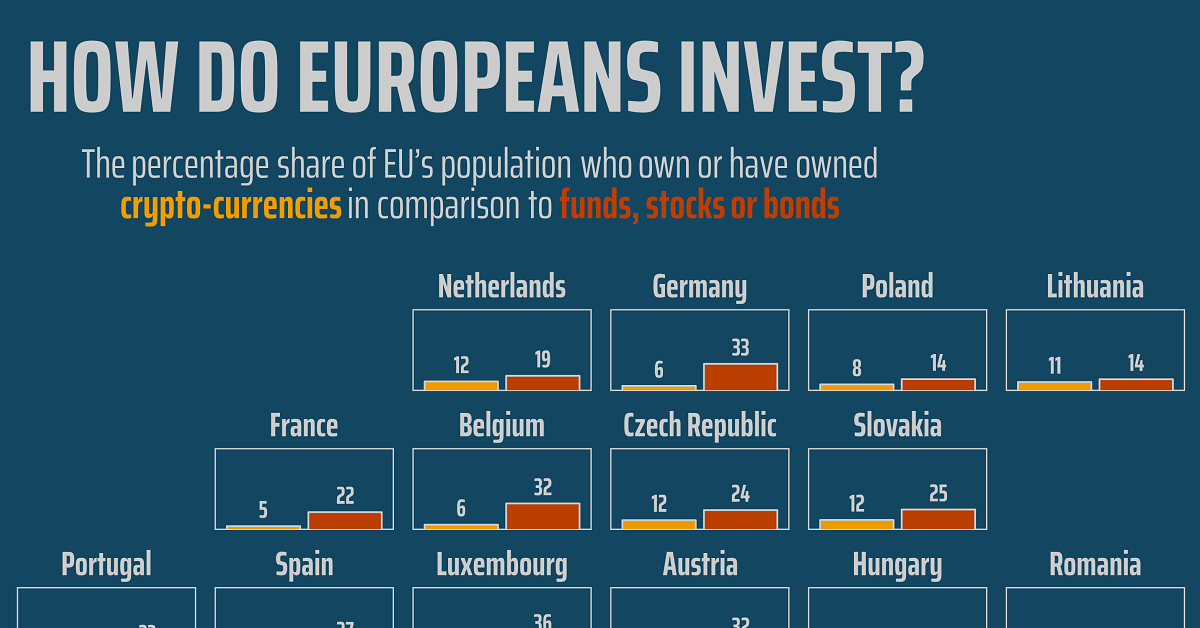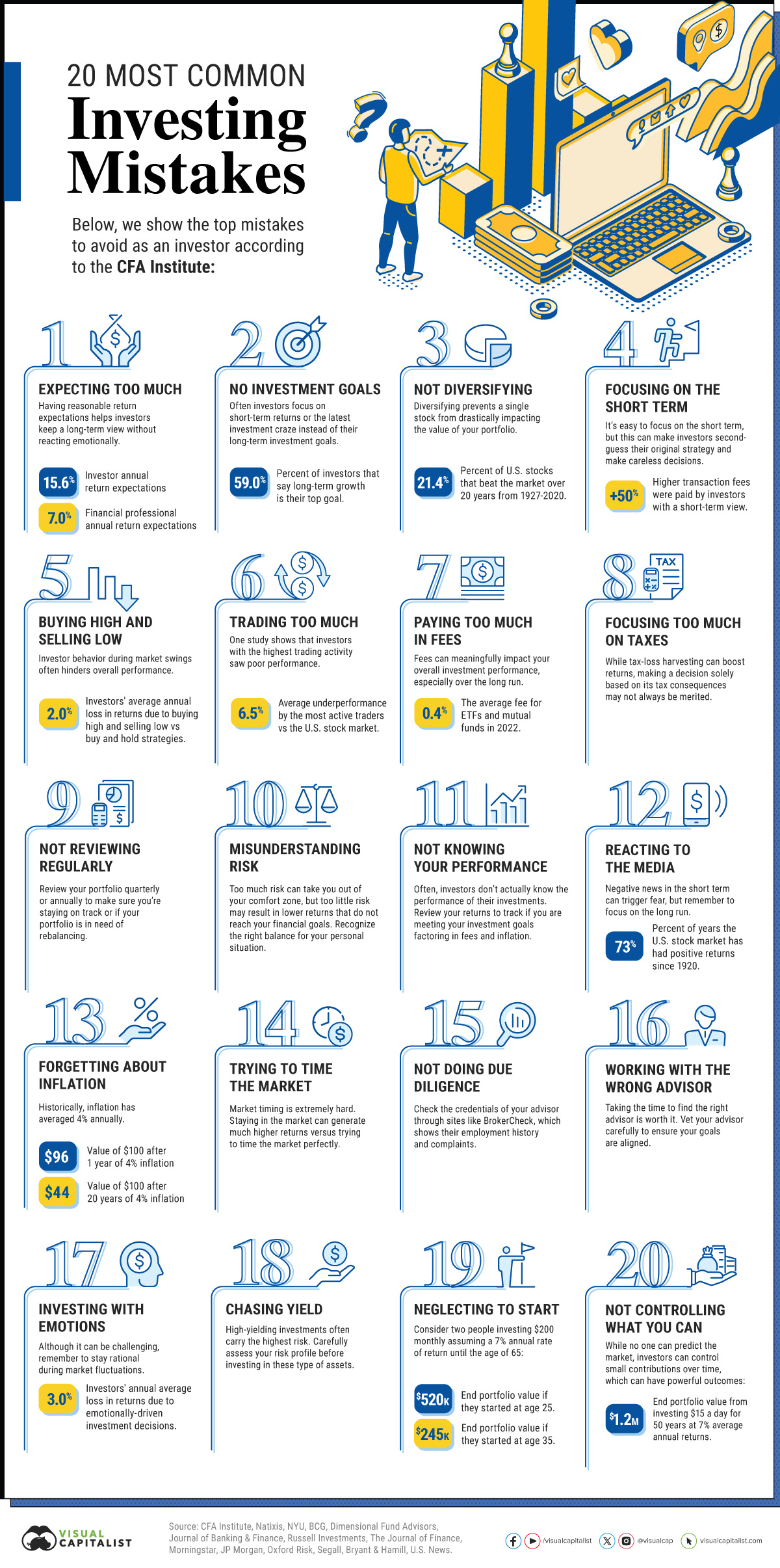Investor Education
Ranked: Crypto Popularity Across European Union Nations

Ranked: Crypto Popularity Across European Union Nations
Depending on where you live, investors can have wildly different preferences when it comes to choosing asset classes.
For a modern example, we can see how different countries (and regions) act when it comes to cryptocurrency. Within the European Union—one of the regions dealing with faster crypto adoption—attitudes towards investing can vary considerably.
This graphic from Gilbert Fontana looks at crypto popularity amongst investors in the EU using data from the European Commission’s Eurobarometer. It compares exposure to cryptocurrencies relative to stocks, funds, and bonds.
Crypto Popularity in Europe in 2022
Given that crypto has experienced bubble-like asset rallies, including a dramatic rise to over a trillion dollars in value before crashing, it’s fair to say it’s well known by now.
But even with a vast rise in awareness, there are still discrepancies between the level of investment crypto receives amongst European Union nations. Let’s see which countries have the highest proportion of citizens invested in crypto:
| Country | Population Investing in Crypto | Population Investing in Traditional Assets |
|---|---|---|
| 🇸🇮 Slovenia | 18% | 22% |
| 🇭🇷 Croatia | 16% | 17% |
| 🇱🇺 Luxembourg | 14% | 36% |
| 🇧🇬 Bulgaria | 13% | 13% |
| 🇨🇾 Cyprus | 13% | 10% |
| 🇸🇰 Slovakia | 12% | 25% |
| 🇦🇹 Austria | 12% | 32% |
| 🇵🇹 Portugal | 12% | 23% |
| 🇨🇿 Czech Republic | 12% | 24% |
| 🇪🇪 Estonia | 12% | 30% |
| 🇳🇱 Netherlands | 12% | 19% |
| 🇱🇹 Lithuania | 11% | 14% |
| 🇮🇪 Ireland | 11% | 21% |
Topping the list is Slovenia, considered by some the most crypto-friendly nation in the world. According to the survey, 18% of the country’s population has some sort of investment in it. Cyprus also ranks high in its crypto-friendly rank and hits an investment figure of 13%.
Also notable is the Grand Duchy of Luxembourg, which despite having a small population of 640,000 also has a strong reputation as a global financial hub. When it comes to crypto, 14% of the population owns or has owned the asset, relative to 36% for stocks, bonds, or funds.
Crypto Unpopularity?
In regards to the countries with lower levels of crypto investment, one observation is that they tend to be wealthier and more developed EU nations. Here’s how the nations at or below the 10% crypto-investment threshold rank:
| Country | Population Investing in Crypto | Population Investing in Traditional Assets |
|---|---|---|
| 🇲🇹 Malta | 10% | 37% |
| 🇸🇪 Sweden | 10% | 60% |
| 🇬🇷 Greece | 10% | 11% |
| 🇫🇮 Finland | 9% | 42% |
| 🇭🇺 Hungary | 8% | 19% |
| 🇷🇴 Romania | 8% | 12% |
| 🇵🇱 Poland | 8% | 14% |
| 🇱🇻 Latvia | 8% | 11% |
| 🇪🇸 Spain | 8% | 27% |
| 🇩🇰 Denmark | 8% | 36% |
| 🇧🇪 Belgium | 6% | 32% |
| 🇩🇪 Germany | 6% | 33% |
| 🇮🇹 Italy | 6% | 31% |
| 🇫🇷 France | 5% | 22% |
At the “bottom” of crypto interest are France, Germany and Italy, also the EU’s largest economies. At a glance, this might suggest that citizens of stronger economies invest less in crypto.
However, it’s important to note that the countries with higher levels of crypto investment tend to have lower levels of wealth on average. Though less of their investors seem to engage in crypto trading, countries like France and Germany might have more comparable levels of crypto investment on a pure dollar-basis.

This article was published as a part of Visual Capitalist's Creator Program, which features data-driven visuals from some of our favorite Creators around the world.
Investor Education
The 20 Most Common Investing Mistakes, in One Chart
Here are the most common investing mistakes to avoid, from emotionally-driven investing to paying too much in fees.

The 20 Most Common Investing Mistakes
This was originally posted on Advisor Channel. Sign up to the free mailing list to get beautiful visualizations on financial markets that help advisors and their clients.
No one is immune to errors, including the best investors in the world.
Fortunately, investing mistakes can provide valuable lessons over time, providing investors an opportunity to gain insights on investing—and build more resilient portfolios.
This graphic shows the top 20 most common investing mistakes to watch out for, according to the CFA Institute.
20 Investment Mistakes to Avoid
From emotionally-driven investment decisions to paying too much on fees, here are some of the most common investing mistakes:
| Top 20 Mistakes | Description |
|---|---|
| 1. Expecting Too Much | Having reasonable return expectations helps investors keep a long-term view without reacting emotionally. |
| 2. No Investment Goals | Often investors focus on short-term returns or the latest investment craze instead of their long-term investment goals. |
| 3. Not Diversifying | Diversifying prevents a single stock from drastically impacting the value of your portfolio. |
| 4. Focusing on the Short Term | It’s easy to focus on the short term, but this can make investors second-guess their original strategy and make careless decisions. |
| 5. Buying High and Selling Low | Investor behavior during market swings often hinders overall performance. |
| 6. Trading Too Much | One study shows that the most active traders underperformed the U.S. stock market by 6.5% on average annually. Source: The Journal of Finance |
| 7. Paying Too Much in Fees | Fees can meaningfully impact your overall investment performance, especially over the long run. |
| 8. Focusing Too Much on Taxes | While tax-loss harvesting can boost returns, making a decision solely based on its tax consequences may not always be merited. |
| 9. Not Reviewing Investments Regularly | Review your portfolio quarterly or annually to make sure you’re staying on track or if your portfolio is in need of rebalancing. |
| 10. Misunderstanding Risk | Too much risk can take you out of your comfort zone, but too little risk may result in lower returns that do not reach your financial goals. Recognize the right balance for your personal situation. |
| 11. Not Knowing Your Performance | Often, investors don’t actually know the performance of their investments. Review your returns to track if you are meeting your investment goals factoring in fees and inflation. |
| 12. Reacting to the Media | Negative news in the short-term can trigger fear, but remember to focus on the long run. |
| 13. Forgetting About Inflation | Historically, inflation has averaged 4% annually. Value of $100 at 4% Annual Inflation After 1 Year: $96 After 20 Years: $44 |
| 14. Trying to Time the Market | Market timing is extremely hard. Staying in the market can generate much higher returns versus trying to time the market perfectly. |
| 15. Not Doing Due Diligence | Check the credentials of your advisor through sites like BrokerCheck, which shows their employment history and complaints. |
| 16. Working With the Wrong Advisor | Taking the time to find the right advisor is worth it. Vet your advisor carefully to ensure your goals are aligned. |
| 17. Investing With Emotions | Although it can be challenging, remember to stay rational during market fluctuations. |
| 18. Chasing Yield | High-yielding investments often carry the highest risk. Carefully assess your risk profile before investing in these types of assets. |
| 19. Neglecting to Start | Consider two people investing $200 monthly assuming a 7% annual rate of return until the age of 65. If one person started at age 25, their end portfolio would be $520K, if the other started at 35 it would total about $245K. |
| 20. Not Controlling What You Can | While no one can predict the market, investors can control small contributions over time, which can have powerful outcomes. |
For instance, not properly diversifying can expose you to higher risk. Holding one concentrated position can drastically impact the value of your portfolio when prices fluctuate.
In fact, one study shows that the optimal diversification for a large-cap portfolio is holding 15 stocks. In this way, it helps capture the highest possible return relative to risk. When it came to a small-cap portfolio, the number of stocks rose to 26 for optimal risk reduction.
It’s worth noting that one size does not fit all, and seeking financial advice can help you find the right balance based on your financial goals.
Another common mistake is trading too much. Since each trade can rake up fees, this can impact your overall portfolio performance. A separate study showed that the most active traders saw the worst returns, underperforming the U.S. stock market by 6.5% on average annually.
Finally, it’s important to carefully monitor your investments regularly as market conditions change, factoring in fees and inflation. This will let you know if your investments are on track, or if you need to adjust based on changing personal circumstances or other factors.
Controlling What You Can
To help avoid these common investing mistakes, investors can remember to stay rational and focus on their long-term goals. Building a solid portfolio often involves assessing the following factors:
- Financial goals
- Current income
- Spending habits
- Market environment
- Expected returns
With these factors in mind, investors can avoid focusing on short-term market swings, and control what they can. Making small investments over the long run can have powerful effects, with the potential to accumulate significant wealth simply by investing consistently over time.
-

 Automotive2 weeks ago
Automotive2 weeks agoTesla Is Once Again the World’s Best-Selling EV Company
-

 AI1 week ago
AI1 week agoThe Stock Performance of U.S. Chipmakers So Far in 2024
-

 Misc1 week ago
Misc1 week agoAlmost Every EV Stock is Down After Q1 2024
-

 Money2 weeks ago
Money2 weeks agoWhere Does One U.S. Tax Dollar Go?
-

 Green2 weeks ago
Green2 weeks agoRanked: Top Countries by Total Forest Loss Since 2001
-

 Markets2 weeks ago
Markets2 weeks agoVisualizing America’s Shortage of Affordable Homes
-

 Maps2 weeks ago
Maps2 weeks agoMapped: Average Wages Across Europe
-

 Mining2 weeks ago
Mining2 weeks agoCharted: The Value Gap Between the Gold Price and Gold Miners













